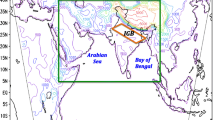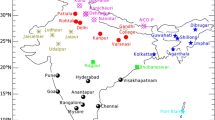Aerosol forcing remains a dominant uncertainty in climate studies. The impact of aerosol direct radiative forcing on Indian monsoon is extremely complex and is strongly dependent on the model, aerosol distribution and characteristics specified in the model, modelling strategy employed as well as on spatial and temporal scales. The present study investigates (i) the aerosol direct radiative forcing impact on mean Indian summer monsoon when a combination of quasi-realistic mean annual cycles of scattering and absorbing aerosols derived from an aerosol transport model constrained with satellite observed Aerosol Optical Depth (AOD) is prescribed, (ii) the dominant feedback mechanism behind the simulated impact of all-aerosol direct radiative forcing on monsoon and (iii) the relative impacts of absorbing and scattering aerosols on mean Indian summer monsoon. We have used CAM3, an atmospheric GCM (AGCM) that has a comprehensive treatment of the aerosol–radiation interaction. This AGCM has been used to perform climate simulations with three different representations of aerosol direct radiative forcing due to the total, scattering aerosols and black carbon aerosols. We have also conducted experiments without any aerosol forcing. Aerosol direct impact due to scattering aerosols causes significant reduction in summer monsoon precipitation over India with a tendency for southward shift of Tropical Convergence Zones (TCZs) over the Indian region. Aerosol forcing reduces surface solar absorption over the primary rainbelt region of India and reduces the surface and lower tropospheric temperatures. Concurrent warming of the lower atmosphere over the warm oceanic region in the south reduces the land–ocean temperature contrast and weakens the monsoon overturning circulation and the advection of moisture into the landmass. This increases atmospheric convective stability, and decreases convection, clouds, precipitation and associated latent heat release. Our analysis reveals a defining negative moisture-advection feedback that acts as an internal damping mechanism spinning down the regional hydrological cycle and leading to significant circulation changes in response to external radiative forcing perturbations. When total aerosol loading (both absorbing and scattering aerosols) is prescribed, dust and black carbon aerosols are found to cause significant atmospheric heating over the monsoon region but the aerosol-induced weakening of meridional lower tropospheric temperature gradient (leading to weaker summer monsoon rainfall) more than offsets the increase in summer-time rainfall resulting from the atmospheric heating effect of absorbing aerosols, leading to a net decrease of summer monsoon rainfall. Further, we have carried out climate simulations with globally constant AODs and also with the constant AODs over the extended Indian region replaced by realistic AODs. Regional aerosol radiative forcing perturbations over the Indian region is found to have impact not only over the region of loading but over remote tropical regions as well. This warrants the need to prescribe realistic aerosol properties in strategic regions such as India in order to accurately assess the aerosol impact.


















Similar content being viewed by others
References
Boer G J 1993 Climate change and the regulation of the surface moisture and energy budgets; Clim. Dyn. 8 225–239.
Bollasina M, Nigam S and Lau K M 2008 Absorbing aerosols and summer monsoon evolution over South Asia: An observational portrayal; J. Climate 21 3221–3239.
Briegleb B P 1992 Delta-Eddington approximation for solar radiation in the NCAR Community Climate Model; J. Geophys. Res. 97 7603–7612.
Cess R D 1985 Nuclear war: Illustrative effects of atmospheric smoke and dust upon solar radiation; Clim. Change 7 237–251.
Chakraborty A, Satheesh S K, Nanjundiah R S and Srinivasan J 2004 Impact of absorbing aerosols on the simulation of climate over the Indian region in an atmospheric general circulation model; Ann. Geophys. 22 1421–1434.
Chung C E and Ramanathan V 2006 Weakening of the north Indian SST gradients and the monsoon rainfall in India and the Sahel; J. Climate 19 2036–2045.
Chung C E, Ramanathan V and Kiehl J T 2002 Effects of the south Asian absorbing haze on the northeast monsoon and surface-air heat exchange; J. Climate 15 2462– 2476.
Coakley J A, Cess R D and Yurevich F B 1983 The effect of tropospheric aerosols on the Earth’s radiation budget: A parameterization for climate models; J. Atmos. Sci. 40 116–138.
Collier J C and Zhang J 2009 Aerosol direct forcing of the summer Indian monsoon as simulated by the NCAR CAM3; Clim. Dyn. 32 313–332.
Collins W D 1998 A global signature of enhanced shortwave absorption by clouds; J. Geophys. Res. 103 31,669–31,679.
Collins W D, Rasch P J, Eaton B E, Khattatov B, Lamarque J-F and Zender C S 2001 Simulating aerosols using a chemical transport model with assimilation of satellite aerosol retrievals: Methodology for INDOEX; J. Geophys. Res. 106 7313–7336.
Collins W D, Bitz C M, Blackmon M L, Bonan G B, Bretherton C S, Carton J A, Chang P, Doney S C, Hack J J, Henderson T B, Kiehl J T, Large W G, McKenna D S, Santer B D, Santer B D and Smith R D 2006a The Community Climate System Model Version 3 (CCSM3); J. Climate 19 2122–2143.
Collins W D, Rasch P J, Boville B A, Hack J J, McCaa J R, Williamson D L, and Briegleb B P 2006b The formulation and atmospheric simulation of the Community Atmospheric Model Version 3 (CAM3); J. Climate 19 2144–2161.
Forster P, Ramaswamy V and Co-authors 2007 Changes in atmospheric constituents and in radiative forcing; In: Climate Change 2007: The Physical Science Basis. Contribution of Working Group I to the Fourth Assessment Report of the Intergovernmental Panel on Climate Change (eds) Solomon S and Co-authors (Cambridge, United Kingdom and New York, NY, USA: Cambridge University Press).
Gadgil S and S Sajani 1998 Monsoon precipitation in the AMIP runs; Clim. Dyn. 14 659–689.
Haywood J M, Roberts D L, Slingo A and Edwards J M and Shine K P 1997 General circulation model calculations of the direct radiative forcing by anthropogenic sulfate and fossil-fuel soot aerosol; J. Climate 19 1562–1577.
Hess M, Koepke P and Schult I 1998 Optical properties of aerosols and clouds: The software package OPAC; Bull. Am. Meteor. Soc. 79 831–844.
Joseph J H, Wiscombe W J and Weinman J A 1976 The delta-Eddington approximation for radiative flux transfer; J. Atmos. Sci. 33 2452–2459.
Kalnay E, Kanamitsu M, Kistler R, Collins W and co-authors 1996 The NCEP/NCAR 40-year reanalysis project; Bull. Am. Meteor. Soc. 77 437–471.
Kiehl J T and Briegleb B P 1993 The relative roles of sulphate aerosols and greenhouse gases in climate forcing; Science 260 311–314.
Koch D and Co-authors 2009 Evaluation of black carbon estimations in global aerosol models. Atmos. Chem. Phys. 9(22) 9001–9026.
Lau K M, Kim M K and Kim K M 2006 Asian monsoon anomalies induced by aerosol direct effects; Clim. Dyn. 26 855–864, doi: 10.1007/s00382-006-0114-z.
Meehl G A, Arblaster J M and Collins W D 2008 Effects of black carbon aerosols on the Indian monsoon; J. Climate 21(12) 2869–2882.
Menon S, Hansen J, Nazarenko L and Luo Y 2002 Climate effects of black carbon aerosols in China and India; Science 297 2250–2253.
Mitchell J F B, Davis R A, Ingram W J and Senior C A 1995 On surface temperature, greenhouse gases, and aerosols: Models and observations; J. Climate 8 2364–2386.
Moorthy K K, Nair P R and Satheesh S K 1998 On the climatology of aerosol optical depths. Global Change Studies; ISRO:GBP(GSC-02-98), pp. 45–66.
Rajendran K and Kitoh A 2008 Indian summer monsoon in future climate projection by a super high resolution global model; Curr. Sci. 95(11) 1560–1569.
Ramanathan V, Chung C, Kim D, Betge T, Buja L, Kiehl J T, Washington W M, Fu Q, Sikka D R and Wild M 2005 Atmospheric brown clouds: Impacts on South Asian climate and hydrological cycle; Proc. Nat. Acad. Sci. USA 102 5326–5333, doi: 10.1073/pnas.0500656102.
Ramanathan V, Ramana M V, Roberts G, Kim D, Corrigan C, Chung C and Winker D 2007 Warming trends in Asia amplified by brown cloud solar absorption; Nature 448 575–578.
Ramanathan V and Carmichael G 2008 Global and regional climate changes due to black carbon; Nature Gepsci. 1 221–227.
Randles C A and Ramaswamy V 2008 Absorbing aerosols over Asia: A geophysical fluid dynamics laboratory general circulation model sensitivity study of model response to aerosol optical depth and aerosol absorption; J. Geophys. Res. 113 D21203, doi: 10.1029/2008JD010140.
Rasch P J, Mahowald N M and Eaton B E 1997 Representations of transport, convection, and the hydrologic cycle in chemical transport models: Implications for the modeling of short-lived and soluble species; J. Geophys. Res. 102 28,127–28,138.
Rayner N A, Parker D E, Horton E B, Folland C K, Alexander L V, Rowell D P, Kent E C and Kaplan A 2003 Global analyses of SST, sea ice and night marine air temperature since the late nineteenth century; J. Geophys. Res. 108, doi: 10.1029/2002JD002670.
Roeckner E L, Bengtsson L, Feichter J, Lelieveld J and Rodhe H 1999 Transient climate change simulations with a coupled atmosphere-ocean GCM including the tropospheric sulfur cycle; J. Climate 12 3004–3031.
Sato M, Hansen J, Koch D, Lacis A, Ruedy R, Dubovik O, Holben B, Chin M and Novakov T 2003 Global atmospheric black carbon inferred from AERONET; Proc. Nat. Acad. Sci. USA 100(11) 6319–6324.
Streets D G and Waldhoff S T 2000 Present and future emissions of air pollutants in China: SO2, NOx, and CO; Atmos. Environ. 345 363–374.
Wang C, Kim D, Ekman A M L, Barth M C and Rasch P J 2009 Impact of anthropogenic aerosols on Indian summer monsoon; Geophys. Res. Lett. 36 L21704, doi: 10.1029GL040114.
Williams K D, Jones A, Roberts D L, Senior C A and Woodage M J 2001 The response of the climate system to the indirect effects of anthropogenic sulfate aerosol; Clim. Dyn. 17 845–856.
Xie P and Arkin P A 1997 Global precipitation: A 17-year monthly analysis based on gauge observations, satellite estimates, and numerical model outputs; Bull. Am. Meteor. Soc. 78 2539–2558.
Zhang G J and McFarlane N A 1995 Sensitivity of climate simulations to the parameterization of cumulus convection in the Canadian Climate Centre general circulation model; Atmos. Ocean 33 407–446.
Zhang H, Wang Z, Pinwen G and Wang Z 2009 A modeling study of the effects of direct radiative forcing due to carbonaceous aerosol on the climate in east Asia; Adv. Atmos. Sci. 26 57–66.
Acknowledgements
The authors are grateful to Prof. J Srinivasan for scientific inputs throughout the study and critical comments on the first version of the manuscript. SS and KR acknowledge the support from Dr Gangan Prathap. The simulations were carried out in C-MMACS HPC. This work was supported by the project R-8-113 under CSIR-EMPOWER Scheme. RSN thanks INCOIS and MoES for their support.
Author information
Authors and Affiliations
Corresponding author
Rights and permissions
About this article
Cite this article
SAJANI, S., KRISHNA MOORTHY, K., RAJENDRAN, K. et al. Monsoon sensitivity to aerosol direct radiative forcing in the community atmosphere model. J Earth Syst Sci 121, 867–889 (2012). https://doi.org/10.1007/s12040-012-0198-2
Received:
Revised:
Accepted:
Published:
Issue Date:
DOI: https://doi.org/10.1007/s12040-012-0198-2




